Force: A push or a Pull
- Books Name
- Class-8 Science Book
- Publication
- PathSet Publications
- Course
- CBSE Class 8
- Subject
- Science
Force: A Push or a Pull
Introduction

- Actions like picking, opening, shutting, kicking, hitting, lifting, flicking, pushing, pulling are often used to describe certain tasks.
- Each of these actions usually results in some kind of change in the motion of an object.
Force
A push or pull on an object is called a Force.
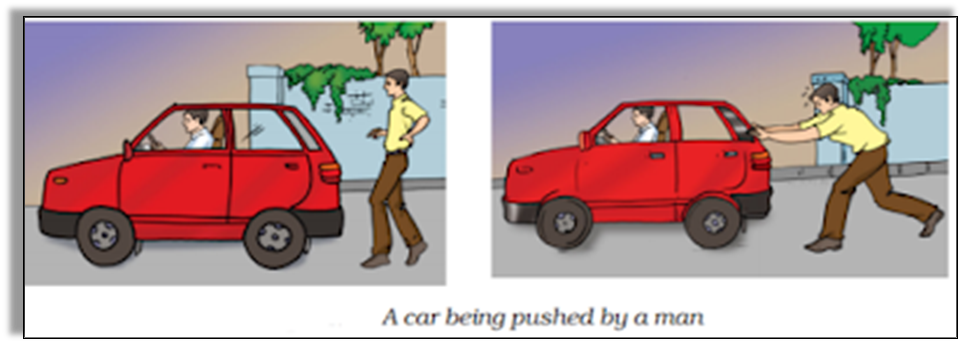
Push: When an object is moving away from the applier of force.
Pull: When an object is moving towards the applier of force.
Force is a push or a pull that changes or tends to change the state of rest or of uniform motion, or direction of motion or the shape or size of a body. More push is required to move a heavy object in comparison to a lighter object.
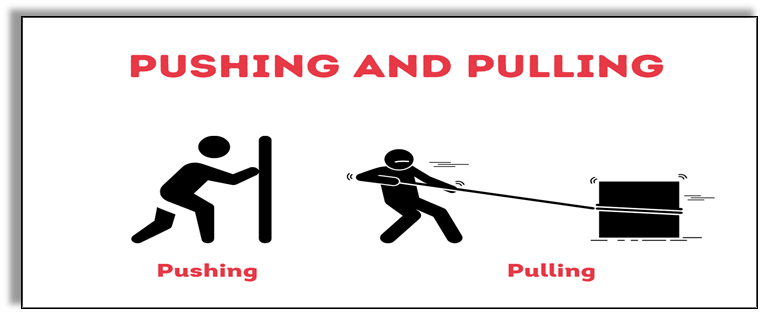
Force:- A push or a pull on an object is called force. Force has both magnitude and direction. Force is any action that has the tendency to change the position, shape, or size of the object. The SI unit of force is the newton. The motion imparted to objects is due to the action of a force.
What causes the force to arise?
- The interaction between two objects arises from the force.
- Force includes gravity, friction and force applied on an object in order to move it. The force causes a change in the speed or direction of motion.
- An object will either be in motion or at rest as a result of forces. If an object is at rest and remains at rest, the forces acting on it are said to be balanced. For it to begin moving, we must apply additional force.
- When force is applied, two objects are involved: one that applies the force and one that receives it.
- For example- A football placed on the ground is at rest position. For it to move in any direction, some force should be applied to the ball. In order to move the ball player can hit the ball.
Forces are due to an Interaction and Exploring Forces
- Books Name
- Class-8 Science Book
- Publication
- PathSet Publications
- Course
- CBSE Class 8
- Subject
- Science
Forces are due to an Interaction:-
- A force arises due to interaction between objects. When applying a force to an object, the interaction between the object and the source of force is required.
- For example- We can exert a force on a ball to move in any direction. It happens when we kick the ball, so the force that arises is due to the interaction between the feet of the player and the ball
- At least two objects must interact for a force to come into play. Thus, an interaction of one object with another object results in a force between the two objects. More than one force may act on an object.
- Whenever force is acting on a body, it causes the displacement in direction of the applied force.
- Two objects must interact for a force to come into play. Thus, an interaction of one object with another object results in a force between the two objects.
- Forces applied on an object in the same direction add to one another.
- If the two forces act in the opposite directions on an object, the net force acting on it is the difference between the two forces.
- Magnitude: The strength of a force is usually expressed by its magnitude
- Force applied could be larger or smaller than the other or equal to each other.
- If the direction or the magnitude of the applied force changes, its effect also changes.
- The net force on an object is zero if the two forces acting on it in opposite directions are equal
Exploring Forces:-
A force can change the state of motion of an object, i.e. a force can make a stationary body move; it can stop a moving body; it can change the speed of the moving body.
If two bodies exert force in the same direction and to the same object then the net force acting on the object is the sum of both the forces exerted by the bodies.
If two bodies exert force on an object from opposite directions then the net force acting on the body will be the difference of the two forces and towards the direction of the larger force.
A Force can Change the State of Motion and the shape of an object
- Books Name
- Class-8 Science Book
- Publication
- PathSet Publications
- Course
- CBSE Class 8
- Subject
- Science
Force can Change of State of Motion:-
A change in either the speed of an object, its direction of motion, or both, is described as a change in its state of motion. A force may bring a change in the state of motion of an object.
Example: A fielder catches a cricket ball coming with great speed and brings it to rest.
Force can Change the State of Motion:
- Force applied to an object may change its speed.
- If the force applied to the object is in the direction of its motion, the speed of the object increases.
- If the force is applied in the direction opposite to the direction of motion, then it results in a decrease in the speed of the object.
- A change in either the speed of an object, its direction of motion, or both, is described as a change in its state of motion.
- Thus, a force may bring a change in the state of motion of an object
- State of motion: an object is described by its speed and the direction of motion.
- The state of rest is considered to be the state of zero speed.
- An object may be at rest or in motion; both are its states of motion.
- Many times, the application of force does not result in a change in the state of motion.
- An object is said to be in motion if it is moving at a certain speed in a particular direction.
- If the object is at rest, it means that it is not changing its position for an observing point. Hence it has zero speed.
- When the object starts moving it means that its position is being changed for an observation point.
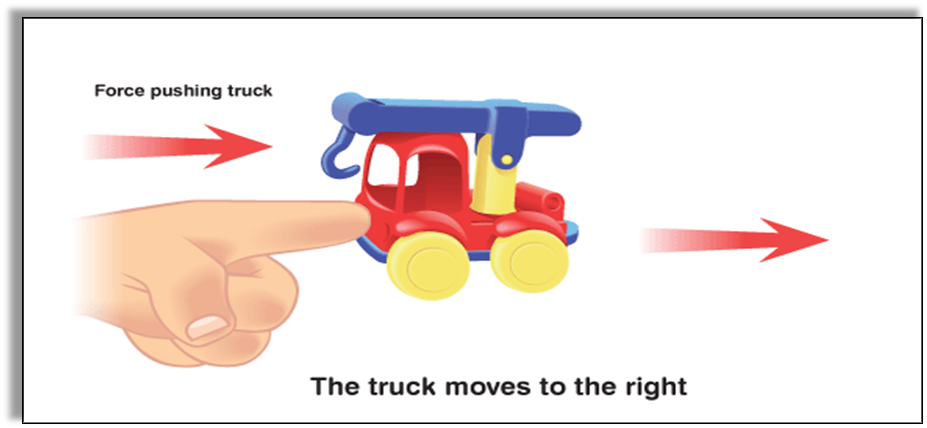
- In order to move an object from one place to another, a force is required to bring that object in motion.
- Not only this, a force applied to an object can change its speed, bring it to rest, or even change the direction of its motion.
- It may bring a combination of these effects as well such as a change in direction of motion and change in the speed of the motion altogether.
- Hence we can say that force can change the state of motion of an object.
- Any object cannot move by itself or change its state of motion on its own without the application of force.
- However, it is not a case that this change of state of motion will take place every time with every kind of object. For instance, if a person tries to push a very heavy object such as a wall, it would not at all.
Force can Change of Shape of an Object:-
A force on an object may change its shape.
Example: Pressing an inflated balloon with two hands compresses the balloon.
Force can lead to change in shape:
An object cannot move by itself, it cannot change speed by itself, it cannot change direction by itself and its shape cannot change by itself.
Force can change the shape of an object
The shape of an object can be altered if some force is applied to it. Depending upon the magnitude of the force that is being applied and the rigidity of the object, the effect on its shape and size can be observed.
Example:
- The above examples show how the use of force in different ways can change the shape of the object.
- So we can say that forces can change the shape of an object.
Effects of Force
Let us now look at some of the characteristics of force
1. A force can change the size and shape of an object. For example – While playing with clay we can change the shape of clay by applying force with our hands. The shape of the rubber band changes when it is stretched.
2. A force can change the speed of a moving object. Force can slow down or completely stop a moving object. To do this we need to apply a force in a direction opposite to the direction of motion of the moving body.
3. A force can move an object which is at rest. For example – A stationary trolley or trolley which is at rest can be made to move by applying some force. So the motion of an object can be halted by suitable application of force.
4. A force can change the direction of motion of a moving object. For example – A football can change its direction by kicking it in a different direction.
Note – Change in the mass of an object is not an effect of force.
Force can Change the Shape of an object
- Books Name
- Class-8 Science Book
- Publication
- PathSet Publications
- Course
- CBSE Class 8
- Subject
- Science
Force can Change of Shape of an Object:-
A force on an object may change its shape. Example: Pressing an inflated balloon with two hands compresses the balloon.
Force can lead to a change in shape: An object cannot move by itself, it cannot change speed by itself, it cannot change direction by itself and its shape cannot change by itself.
Force can change the shape of an object
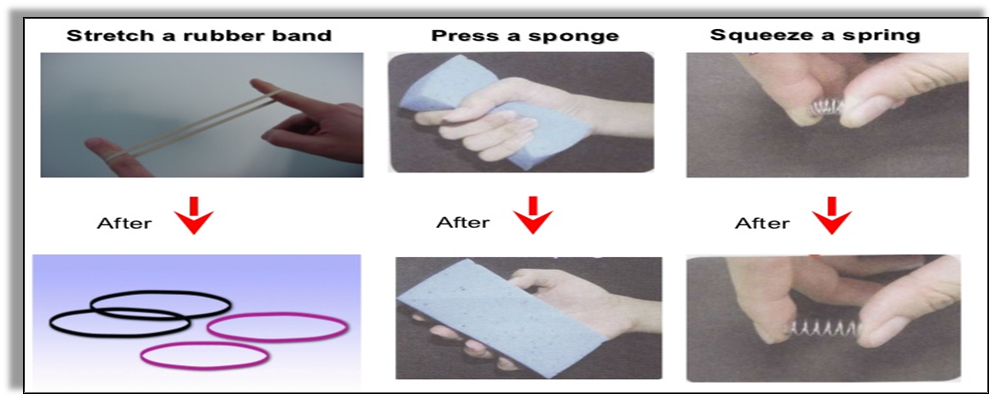
The shape of an object can be altered if some force is applied to it. Depending upon the magnitude of the force that is being applied and the rigidity of the object, the effect on its shape and size can be observed.
Example:
- The above examples show how the use of force in different ways can change the shape of the object.
- So we can say that forces can change the shape of an object.
Effects of Force
Let us now look at some of the characteristics of force:
- A force can change the size and shape of an object. For example – While playing with clay we can change the shape of clay by applying force with our hands. The shape of the rubber band changes when it is stretched.
- A force can change the speed of a moving object. Force can slow down or completely stop a moving object. To do this we need to apply a force in a direction opposite to the direction of motion of the moving body.
- A force can move an object which is at rest. For example – A stationary trolley or trolley which is at rest can be made to move by applying some force. So the motion of an object can be halted by suitable application of force.
- A force can change the direction of motion of a moving object. For example – A football can change its direction by kicking it in a different direction.
Note – Change in the mass of an object is not an effect of force.
Contact Forces
- Books Name
- Class-8 Science Book
- Publication
- PathSet Publications
- Course
- CBSE Class 8
- Subject
- Science
Types of Force

Contact Force:-
The forces which act on bodies when they are in physical contact with each other are called the Contact forces. Example - muscular force, friction force.
Non-Contact Force:-
The forces experienced by bodies even without being physically touched are called the Non-Contact Forces. Examples - electrostatic force, gravitational force and magnetic force.
CONTACT FORCE
- The force that comes into action after the interaction between objects is called contact force.
- Contact force works on the point of contact.
- Example - pushing a car, hitting the ball, kicking a ball, etc.
Muscular force, Friction Force are types of Contact Force.
1. Muscular Force
The force that comes into play because of the action of muscles is called muscular force.
For example:
- Human beings use muscular force in order to walk.
- The expansion and contraction of the lungs is because of muscular force
- Movement of food along the food pipe
- Animals can also exit muscular forces; that's why they can move from one place to another
- Pushing the object like a school bag or lifting the dumbles for exercising
- we use the muscular force.
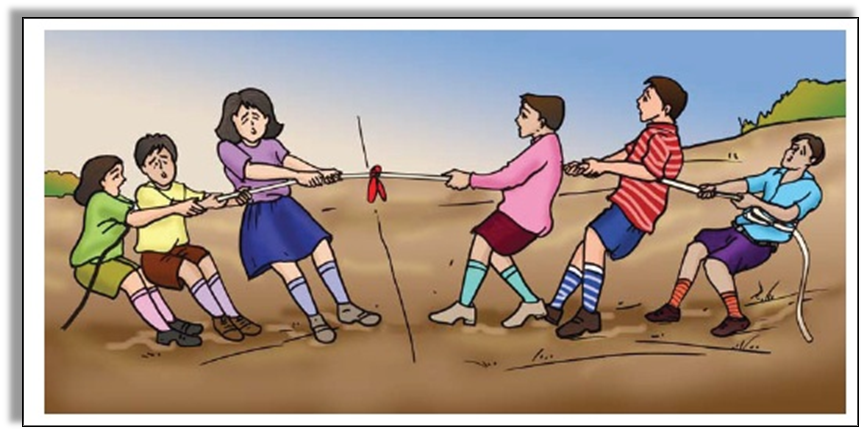
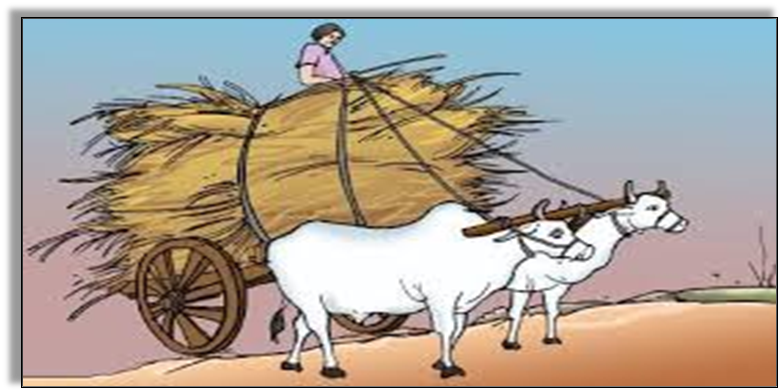
2. Friction Force:
- Forces of friction arise between the surfaces of two objects.
- Always acts on all moving objects and its direction is always opposite to the direction of motion.
- The Force of the friction comes into action only after interaction between two objects, thus, it is a type of contact force.
- It is the force that is exerted by the surface over an object whenever the object moves on the surface.
Force of friction has the following characteristics:
- The force of friction always acts in the opposite direction of the motion of the object.
- It leads to the generation of heat as two surfaces come in contact with each other. For example, when we rub our hands together, heat is produced as a result of friction between our hands.
The frictional force also leads to wear and tear of the surfaces of objects that come in contact with each other. For example, the sole of shoes often gets worn out due to friction force that acts between them and the ground as we walk
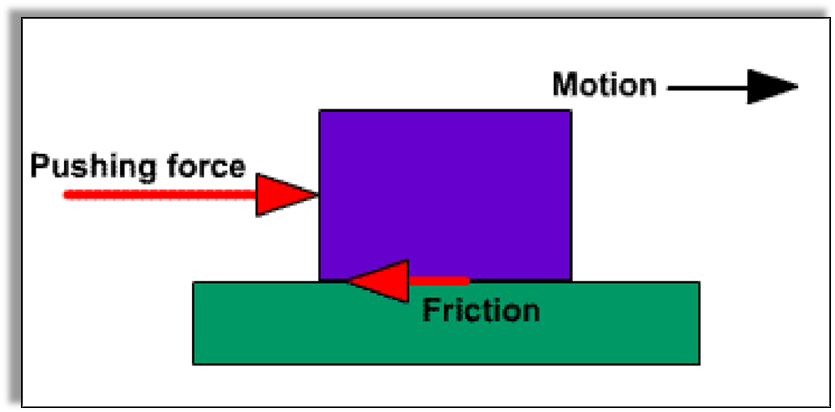
Example: Due to the force of friction between the surface of the ball and the ground that brings the moving ball to rest.

Non-contact Forces
- Books Name
- Class-8 Science Book
- Publication
- PathSet Publications
- Course
- CBSE Class 8
- Subject
- Science
NON- CONTACTING FORCES
Force due to without interaction between two objects is called non-contact force. For example; a magnet can pull an iron nail from a distance.
Magnetic force, Electrostatic force, and Gravitational force are examples of non-contact force.
(a) Magnetic Force
- A magnet can exert a force on another magnet without being in contact with it.
- The force exerted by a magnet is an example of a non-contact force.
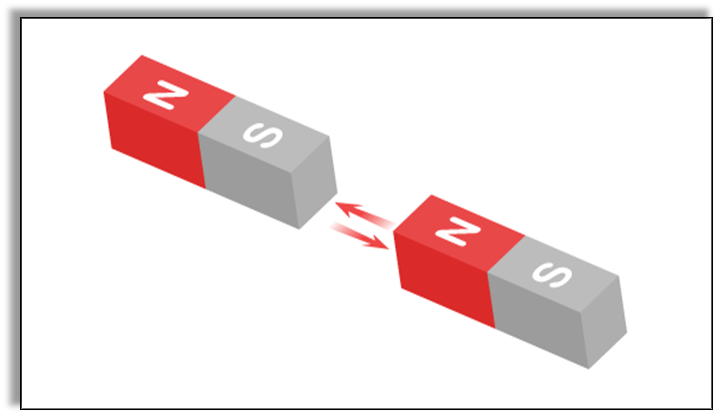
Example: Opposite poles of two magnets attract each other and the same pole repel each other.
(b) Electrostatic Force
- When a charged body exerts a force on another charged or uncharged body is called electrostatic force.
- A positively charged body attracts a negatively charged body and repels a positively charged body without coming in contact, thus it is a non-contact force.
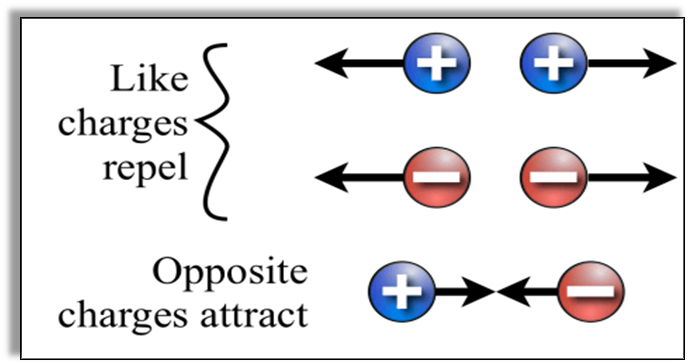
Example: A straw rubbed with paper attracts another straw.
- The figure below shows Electrostatic force acting on bits of paper from a distance
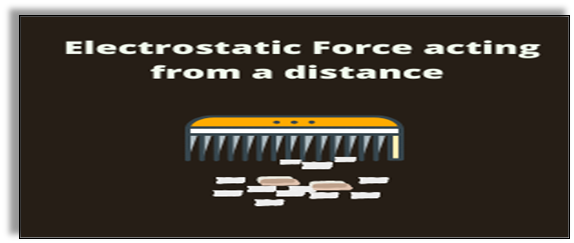
Gravitational Force:
- This force is exerted by the earth, moon, sun, and other planets to others.
- Since, the earth attracts all objects even without coming in contact, thus the gravitational force is a non-contact force.
- The force that pulls the objects towards the earth.
- It is the force of attraction between the particles of matter.
- For example – The falling of an apple from a tree
Example: When we release an object from a height, it falls over the ground because of the gravitational attraction of the earth.
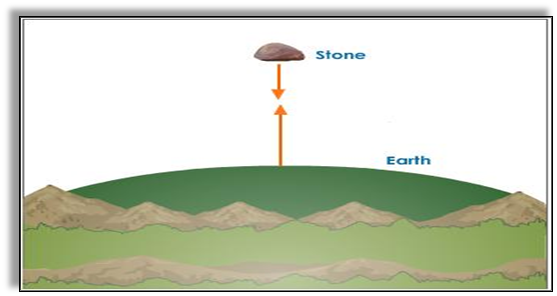
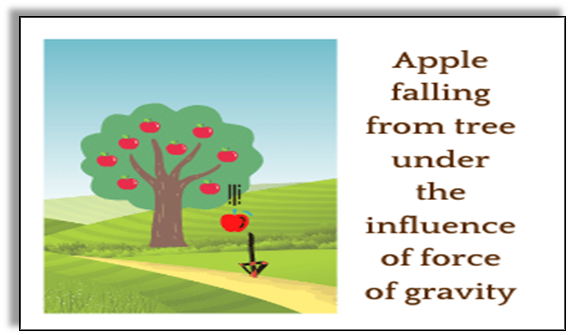
Force Concept Map
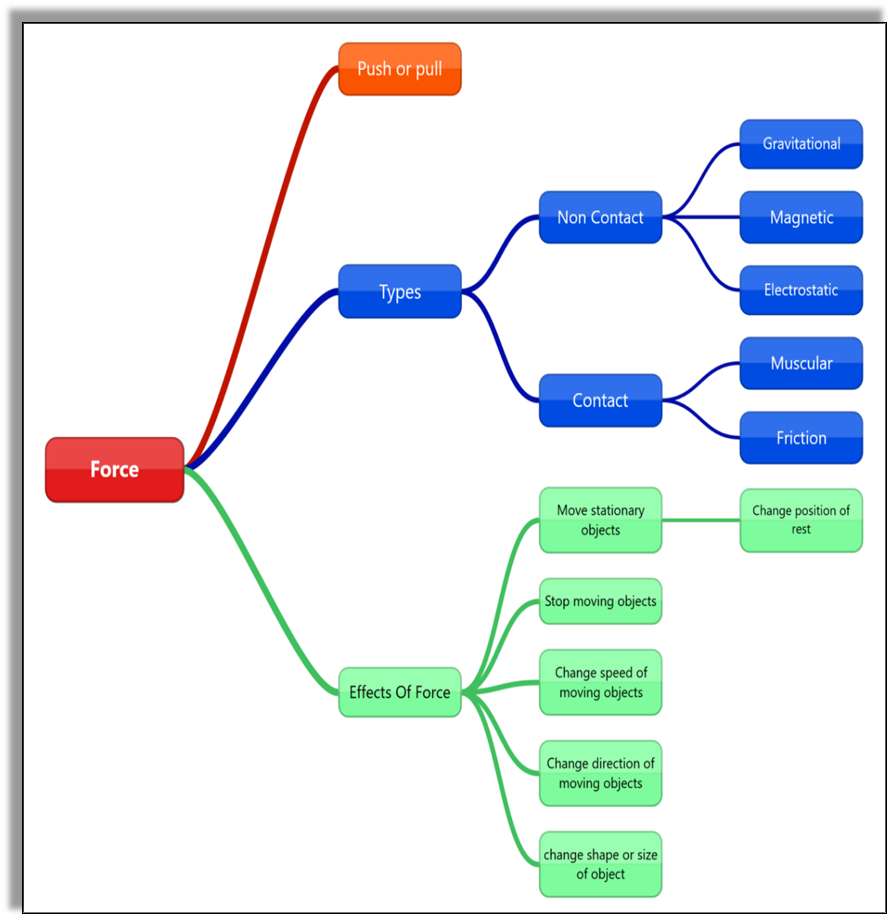
Pressure, Pressure Exerted by Liquids and Gases, Atmospheric Pressure
- Books Name
- Class-8 Science Book
- Publication
- PathSet Publications
- Course
- CBSE Class 8
- Subject
- Science
Pressure
The force acting per unit area of a surface is called pressure or we can say force per unit area is called pressure.
Pressure = Force / Area
From this formula, we can say Pressure is indirectly proportional to the area, thus pressure decreases with an increase in area and increases with a decrease in area.
Example -
- When we cut an apple, we need to use the sharp edge of the knife instead of a blunt knife because the sharp edge of the knife has a small surface area and we need to exert less force with high pressure to cut the apple.
- When we put a nail into a wooden board, the pointed end of the nail is kept at the front. The pointed end of the nail has a very small surface area and this enables us to apply greater pressure with the applied force.
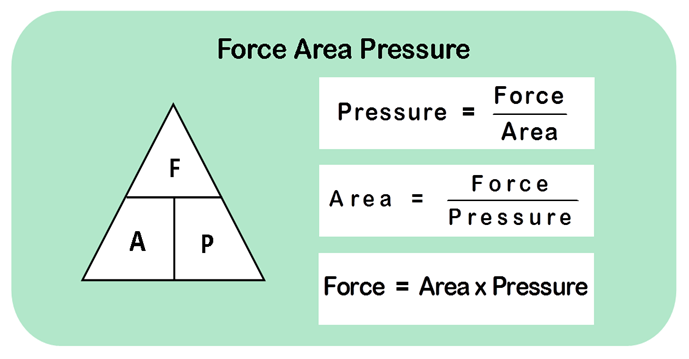
Unit of Pressure
The SI unit of pressure is Pascal.
The SI unit of pressure is Pascal (Pa) or N/m2
1Pa=1N/m21Pa=1N/m2
Applications of Pressure in our Daily Life
- Broad Straps of shoulder bags:- The straps of shoulder bags are made broader which increases the area of contact and reduces the pressure on the shoulders. We know that pressure is inversely proportional to area, thus the wider the area, the less pressure is exerted, making it easier to carry a shoulder bag with a wide strap.
- Elephants have broader feet, which increases the area of contact with the ground and results in lower pressure, and enables the elephants to walk easily.
- It is easier to hammer a sharp iron nail than to hammer a blunt one because the area of a sharp iron nail is smaller than that area of a blunt nail. So, it becomes easier to hammer the nail into the wall.
- The use of skies helps to walk on snow as skies increase the area of contact between our feet and snow. This reduces pressure on the snow.
- Peeling vegetables with a blunt knife is tough. It is much easier to peel vegetables using a sharp knife that has sharp edges rather than a blunt knife. This is because the sharp edge of the knife has a small surface area and less force delivers the amount of pressure needed to cut or peel vegetables.
Pressure Exerted by Liquids and Gases
- It is the force exerted by liquids or gases per unit area.
- Liquids and gases exert pressure in all directions. The pressure inside them increases with depth.
- Liquid and gas can also exert pressure on the inner walls of the container in which they are kept.
- When air is filled, a rubber balloon gets inflated from all sides. This happens due to air or gas exerts pressure over the inner walls of the balloon.
- Water starts leaking if there is a pore in the bottle. This happens due to water exerts pressure over the walls of the bottle.
Pressure Exerted By Liquids
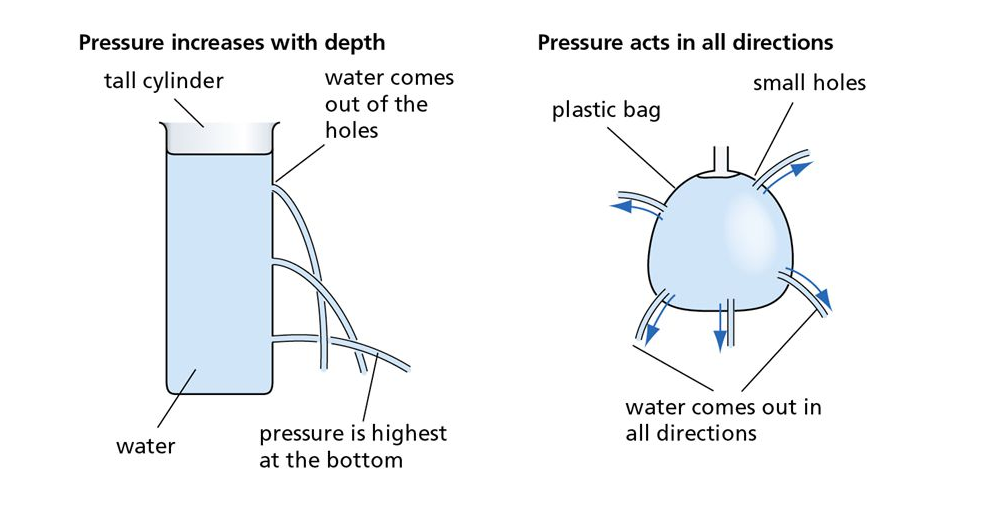
- Liquids exert pressure due to the weight that liquid possesses.
- The liquid posses pressure in the downward direction.
- The pressure exerted by liquids at the bottom depends on the height of the liquid column. The pressure exerted by liquids increases with depth.
- For example – The body of the submarine is thick and built by strong material because the pressure of water is high in deep-sea so to withstand that pressure submarine is thick.
- Liquids also exert pressure in all directions on the walls of the container.
- For example – Take a container and make a hole in it. Now close the holes with tape and fill the container with water. Then remove the tape. We will observe that water comes out of the container in all directions.
- This shows that liquids exert pressure in all directions.
Pressure Exerted by Gases
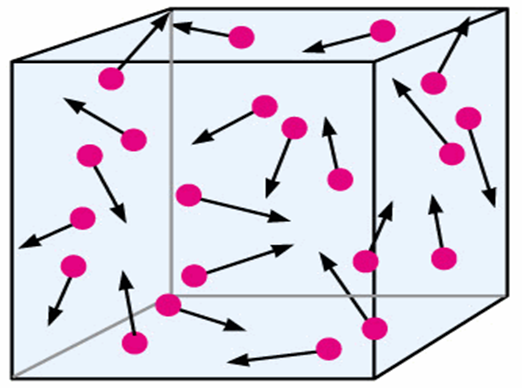
- Gases too exert pressure on the walls of containers like liquids. Air pressure arises due to constant collisions of tiny molecules of gases present in the air with the walls of the container it is enclosed.
- For example- When air is pumped into a bicycle tube by using a pump, the bicycle gets inflated due to air pressure exerted by the collisions of gas molecules in air with the inner walls of the rubber tube. For this reason, bicycle tyres feel hard.
ATMOSPHERIC PRESSURE
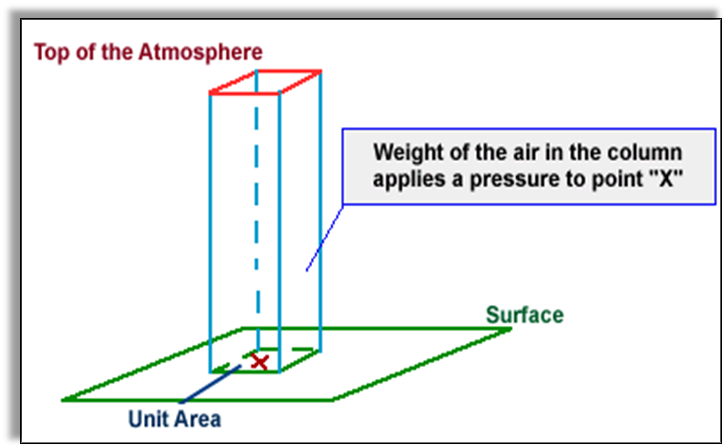
The amount of atmospheric pressure upon us is quite large due to the large surface area of the atmosphere around the earth but we do not experience any of its effects.
Atmosphere – The blanket of air that surrounds the earth is called the atmosphere.
- Our Atmosphere is made of different types of gases. Since gases exert pressure, thus Pressure exerted by air (present in the atmosphere) is called atmospheric pressure.
- The weight of air in a column of the height of the atmosphere and area 10 cm x 10 cm is as large as 1000 kg. The reason we are not crushed under this weight is that the pressure inside our bodies is also equal to the atmospheric pressure and cancels the pressure from outside.
- A pressed rubber sucker on a plane surface does not come off because of All fluids (liquids and gases) exert pressure. So the air also exerts a pressure called atmospheric pressure.
- Atmospheric pressure is the pressure within the atmosphere of Earth. Atmospheric pressure is due to the weight of air present in the atmosphere above us. This pressure causes air molecules to be more tightly packed together than those that are high in the atmosphere. On the surface of the earth, the atmospheric pressure is maximum at sea level.
- Atmospheric pressure also exists in all directions. The instrument used for the measurement of atmospheric pressure is known as a Barometer.
There are two types of barometer-
Mercury barometer
Aneroid barometer
- The mercury barometer is an ideal one as it gives the standard unit of atmospheric pressure.
- In a mercury barometer, a column of mercury in a glass tube rises or falls the weight of atmospheric pressure changes.
- The approximate value of atmospheric pressure on the earth’s surface is 1.013×105 pascal.
However sometimes at higher altitudes where the atmospheric pressure is low as compared to that at the Earth’s surface (low altitudes), nose bleeding occurs.
This is so because at that time the blood pressure in our body becomes higher than the atmospheric pressure outside us.

 PathSet Publications
PathSet Publications
